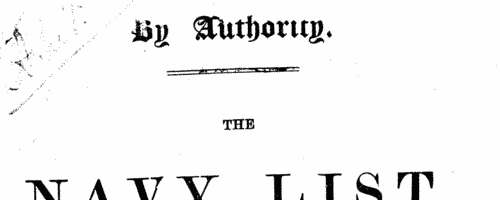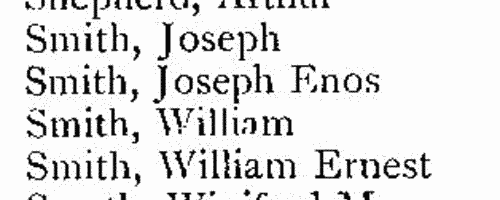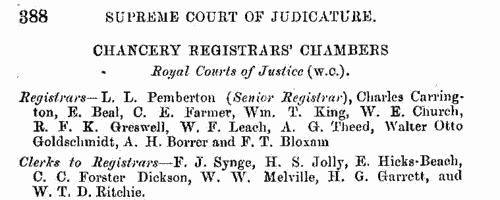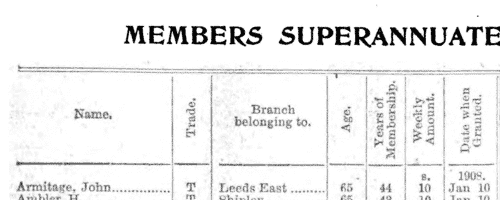Add this eBook to your basket to receive access to all 1,146 records. Our indexes include entries for the spelling swan. In the period you have requested, we have the following 1,146 records (displaying 991 to 1,000): These sample scans are from the original record. You will get scans of the full pages or articles where the surname you searched for has been found. Your web browser may prevent the sample windows from opening; in this case please change your browser settings to allow pop-up windows from this site. Sub-Lieutenants of the Royal Naval Reserve
(1904)
The Monthly Naval List for November 1904, printed By Authority for the Admiralty, contains these Royal Naval Reserve Seniority Lists: giving full name (preceded by an 'm' for those entitled to a naval medal) and date of seniority. The names may be preceded by an asterisk, for those who had completed 12 months' training in the Royal Navy; a further asterisk for 12 months' more service; a dagger for a certificate in a gunnery or torpedo short course; a double dagger for certificates in both; a double S for those who had served in the Fleet for one or more short cruises only; engineer officers marked * had completed a three months' course of instruction at one of the Home Dockyards. | Sample scan, click to enlarge

|  Queen's South Africa Medal: Royal Field Artillery: 37th Battery
(1901-1905) Queen's South Africa Medal: Royal Field Artillery: 37th Battery
(1901-1905)
The nominal roll for the Queen Victoria's South Africa Medal - awarded (after her death, in the event) to all who had served honourably in the various campaigns in the Boer War - was compiled from these returns from the individual units. Two sets of form were completed. The main one, as in the sample scan, dates from 1901 and gives regimental number, rank, and full name (surname first), followed by a series of columns relating to different actions - Belmont, Modder River, Paardeberg, Dreifontein, Wepener, Johannesburg, Diamond Hill, Belfast, Wittebergen, Defence of Kimberley, Relief of Kimberley, Defence of Mafeking, Relief of Mafeking, Cape Colony, Orange Free State, Transvaal, Rhodesia, Talana, Elandslaagte, Tugela Heights, Defence of Ladysmith, Relief of Ladysmith, Laing's Nek, and Natal; each entitled the man to a separate clasp to the medal, and a tick or a Yes in the appropriate column indicates the man's actual physical presence in that battle. A final column for remarks is important in those cases where the man was no longer in the unit, by removal, death or desertion. The second form that sometimes occurs was returned in 1905, and covers men entitled to the Second South African War Medal and Clasps. It lists men by number, rank and name, checks whether they had claimed the Queen's South Africa Medal, and then enquires as to their suitability as to three Colony Clasps, which could be awarded for service in the Cape, Orange Free, or Transvaal; whether entitled to Date Clasps (South Africa 1901 and South Africa 1902); whether also entitled to the King's South Africa Medal; any other corps in which served in South Africa; and remarks (such as becoming non-effective, forfeiture, &c.) WO 100/141 | Sample scan, click to enlarge

|  Queen's South Africa Medal: Royal Field Artillery: 5th Battery
(1901-1905) Queen's South Africa Medal: Royal Field Artillery: 5th Battery
(1901-1905)
The nominal roll for the Queen Victoria's South Africa Medal - awarded (after her death, in the event) to all who had served honourably in the various campaigns in the Boer War - was compiled from these returns from the individual units. Two sets of form were completed. The main one, as in the sample scan, dates from 1901 and gives regimental number, rank, and full name (surname first), followed by a series of columns relating to different actions - Belmont, Modder River, Paardeberg, Dreifontein, Wepener, Johannesburg, Diamond Hill, Belfast, Wittebergen, Defence of Kimberley, Relief of Kimberley, Defence of Mafeking, Relief of Mafeking, Cape Colony, Orange Free State, Transvaal, Rhodesia, Talana, Elandslaagte, Tugela Heights, Defence of Ladysmith, Relief of Ladysmith, Laing's Nek, and Natal; each entitled the man to a separate clasp to the medal, and a tick or a Yes in the appropriate column indicates the man's actual physical presence in that battle. A final column for remarks is important in those cases where the man was no longer in the unit, by removal, death or desertion. The second form that sometimes occurs was returned in 1905, and covers men entitled to the Second South African War Medal and Clasps. It lists men by number, rank and name, checks whether they had claimed the Queen's South Africa Medal, and then enquires as to their suitability as to three Colony Clasps, which could be awarded for service in the Cape, Orange Free, or Transvaal; whether entitled to Date Clasps (South Africa 1901 and South Africa 1902); whether also entitled to the King's South Africa Medal; any other corps in which served in South Africa; and remarks (such as becoming non-effective, forfeiture, &c.) WO 100/140 | Sample scan, click to enlarge

|  Queen's South Africa Medal: Royal Horse Artillery: A Battery
(1901-1905) Queen's South Africa Medal: Royal Horse Artillery: A Battery
(1901-1905)
The nominal roll for the Queen Victoria's South Africa Medal - awarded (after her death, in the event) to all who had served honourably in the various campaigns in the Boer War - was compiled from these returns from the individual units. Two sets of form were completed. The main one, as in the sample scan, dates from 1901 and gives regimental number, rank, and full name (surname first), followed by a series of columns relating to different actions - Belmont, Modder River, Paardeberg, Dreifontein, Wepener, Johannesburg, Diamond Hill, Belfast, Wittebergen, Defence of Kimberley, Relief of Kimberley, Defence of Mafeking, Relief of Mafeking, Cape Colony, Orange Free State, Transvaal, Rhodesia, Talana, Elandslaagte, Tugela Heights, Defence of Ladysmith, Relief of Ladysmith, Laing's Nek, and Natal; each entitled the man to a separate clasp to the medal, and a tick or a Yes in the appropriate column indicates the man's actual physical presence in that battle. A final column for remarks is important in those cases where the man was no longer in the unit, by removal, death or desertion. The second form that sometimes occurs was returned in 1905, and covers men entitled to the Second South African War Medal and Clasps. It lists men by number, rank and name, checks whether they had claimed the Queen's South Africa Medal, and then enquires as to their suitability as to three Colony Clasps, which could be awarded for service in the Cape, Orange Free, or Transvaal; whether entitled to Date Clasps (South Africa 1901 and South Africa 1902); whether also entitled to the King's South Africa Medal; any other corps in which served in South Africa; and remarks (such as becoming non-effective, forfeiture, &c.) WO 100/139 | Sample scan, click to enlarge

| Bengal Civil Servants
(1905)
The India List and India Office List was compiled from official records by direction of the Secretary of State for India in Council, and published by the India Office annually. It covers civil servants and military except for officers drawing substantive pay of less than 500 rupees a month. Names shown in italics are those of officers in foreign service, supernumerary, seconded or employed outside their own departments. This gradation list of covenanted civil servants on the Bengal Establishment, arranged by seniority (dating back to 1861), gives these men (who are also to be found in the lists relating to the provinces and departments in which they were serving) with names in full, honours, and their substantive appointments as in 1905. | Sample scan, click to enlarge

| Bengal Land Revenue Department
(1905)
The India List and India Office List was compiled from official records by direction of the Secretary of State for India in Council, and published by the India Office annually. It covers civil servants and military except for officers drawing substantive pay of less than 500 rupees a month. Names shown in italics are those of officers in foreign service, supernumerary, seconded or employed outside their own departments. This list, for the Land Revenue and General Administration of the lieutenant-governorship of Bengal, includes the commissioners, magistrates and collectors, joint magistrates and deputy collectors, and assistant magistrates and collectors; as well as the deputy magistrates and deputy collectors for the Executive Branch of Provincial Civil Service. | Sample scan, click to enlarge

| Organists
(1905)
The calendar of the Trinity College of Music, London, for 1905-1906 includes a section listing organ associates and certificated organists. | Sample scan, click to enlarge

| Carpenters Excluded from their Union: Stockport (1907)
The 48th annual report of the Amalgamated Society of Carpenters and Joiners, from December 1906 to December 1907, gives lists of members excluded from the union: the great majority for arrears of membership fees, but some for 'non-payment of entrance money'; 'for working contrary to the society's interest'; 'false declaration of entry'; 'imposing on the society's funds'; 'withholding the funds of the society'; 'violating rule while on sick benefit'; 'bringing the society into discredit'; and 'members who have paid up and resigned'.
| Sample scan, click to enlarge

| Civil Servants and Office Holders
(1907)
The Imperial Calendar gives lists of officials and office-holders throughout England, Wales, Scotland and Ireland
| Sample scan, click to enlarge

| Superannuated Engineers (1908)
Members of the Amalgamated Society of Engineers superannuated during 1908. The list gives the member's full name (surname first), trade (BF=brass finisher; CS=copper smith; F=fitter; M=machinist; MJ=machine joiner; MW=millwright; PM=pattern maker; S=smith; T=turner), branch, age, years of membership; weekly amount (in shillings); and date when granted.
| Sample scan, click to enlarge

|
Research your ancestry, family history, genealogy and one-name study by direct access to original records and archives indexed by surname.
|












